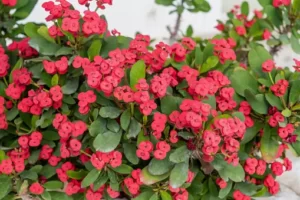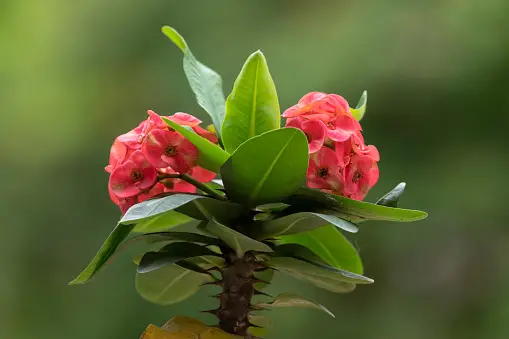Introduction
There are innumerable possibilities available in the world of indoor plants, each with special charms and advantages. One such alluring plant is the exceptional succulent native to Madagascar known as the Crown of Thorns (Euphorbia milii). This houseplant has gained popularity among both experts and novices due to its remarkable look and hardiness. We will examine the unique qualities and maintenance needs of the Crown of Thorns in this blog post, emphasizing why it merits a prominent position in your indoor garden.
Significance of Crown of Thorns:
A Magnificent Beauty
The houseplant Crown of Thorns has a captivating display of colorful blossoms that might be fiery red, delicate pink, yellow, or white. The plant gets its name from how these tiny flowers are grouped together to resemble a crown. It stands out as an accent to any space thanks to the contrast of its vibrant bracts with its thick, spiky stalks.

Low-Upkeep and Resilient
The ability of the Crown of Thorns to flourish under less-than-ideal circumstances is one of its greatest advantages. It has developed adaptations as a succulent to live in dry environments, making it remarkably drought-tolerant. It is a great option for folks who do not have a green thumb or have a tendency to miss watering schedules because of its durability. It’s crucial to remember that while it may tolerate brief periods of neglect, constant maintenance will guarantee its optimum health and development.
Considerations for safety
The Crown of Thorns is a gorgeous indoor plant, but because of its thorns, care must be taken. If handled incorrectly, the stems’ pointed spines could hurt someone. Wear safety gloves when pruning or propagating to protect your hands from potential pricks. Keep the plant away from children and animals as well, who can be enticed to touch or gnaw on its prickly branches.
Cultural Significance and Symbolism
The Crown of Thorns has cultural and symbolic importance in numerous places in addition to its aesthetic worth. It is linked to a variety of theological and historical allusions, including the crown that Jesus wore during his crucifixion in Christian traditions. The plant is regarded in some cultures as bringing luck, wealth, and defense against evil spirits. Your enjoyment of this plant’s beauty can be enhanced by learning about the cultural settings and meanings associated with it.
Bringing Joy to Others
The Crown of Thorns is a great gift option for loved ones, close associates, or gardeners. It is a nice and significant gift for a variety of occasions, including birthdays, housewarmings, or religious festivities, thanks to its distinctive design, durability, and symbolism. By growing the plant and distributing cuttings or potted examples to others, you can spread your love of gardening. It’s a great opportunity to share the delight of caring for and being close to nature.
Care of Crown of Thorns:
Conditions for Sunlight and Temperature
The Crown of Thorns requires a lot of direct, strong sunlight to thrive. It is best to place the plant in a window that faces south or west so that it can get at least six hours of sunshine every day. The plant should be shielded from the sweltering noon sun, though, as it can harm the foliage. This houseplant loves a warm climate with temperatures between 65 and 85 degrees Fahrenheit (18 and 29 degrees Celsius).
Water and Soil
The Crown of Thorns is a succulent that has evolved to store water in its thick stems and leaves. This indicates that it can endure dry spells and that it favors soil with good drainage. In order to avoid root rot when watering, it is best to let the soil dry out between applications. Furthermore, it’s crucial to prevent overwatering because this can result in fungus problems. Reduce watering over the winter to allow the plant to enter a dormant state.
Propagation and Pruning
The Crown of Thorns can be kept in the proper size and shape with regular trimming, which also promotes blooming. Any dead or damaged branches should be removed using clean, sharp pruning shears. Use caution when handling the plant because of its irritant-causing spiky spines. Stem cuttings can also be used to multiply the Crown of Thorns. Before planting the cuttings in well-draining soil, let the cuttings callus for a few days. Soon, you’ll have new plants to share or add to your collection.
Read About: How to make fruit in little alchemy
Fertilizer Needs
It’s crucial to provide the Crown of Thorns with the proper nourishment in order to promote healthy development and vivid blooms. A balanced, water-soluble fertilizer made especially for succulents can be applied to the plant every two to three weeks during the active growing season, which normally runs from spring to summer. To prevent overfeeding, which can result in leaf burn or stunted growth, be sure to adhere to the fertilizer’s packaging directions. You can cut back on fertilizer during the dormant winter months or stop it altogether.
Pest management
Generally speaking, the Crown of Thorns is a pest and disease-resistant plant. However, common houseplant pests like mealybugs, scale insects, or spider mites might infrequently cause it harm. Check the leaves and stems frequently for any indications of infestation, such as minute webs, cottony clusters, or sticky buildup. If pests are present, use organic insecticidal soap or a moist cloth to gently wipe the troubled areas. By acting quickly, you can stop pests from infecting further plants in your collection.
Conclusion:
A wonderful jewel that adds elegance, toughness, and a dash of exotic flair to any indoor garden is the Crown of Thorns houseplant. It’s a fantastic choice for both novice and seasoned plant enthusiasts due to its eye-catching flowers, low maintenance requirements, and capacity to survive in a range of environments. You may enjoy the bright display of this alluring succulent for years to come by giving it enough sunlight, well-draining soil, and regular watering. So appreciate the beauty of nature and think about adding the Crown of Thorns to your collection of plants right away.
